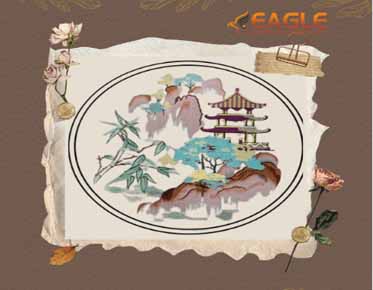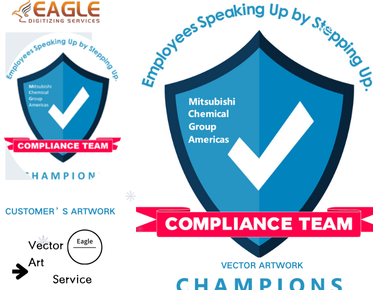Unveiling Machine Embroidery in Digitized Embroidery
Machine
embroidery is a fascinating technique that
utilizes computerized designs to create intricate patterns on fabric. In digitized embroidery, these designs are transformed
into digital files that guide embroidery machines for precise stitching. In
this article, we'll delve into the world of machine embroidery, exploring its
processes, benefits, and the technology behind this art form.
Unraveling the Threads: What is Machine Embroidery?
Machine
embroidery is a captivating intersection of artistry and technology, where fabric
becomes a canvas for intricate designs, patterns, and text. This craft involves
the use of specialized machines to stitch pre-programmed designs into fabric,
allowing for a level of precision and speed that hand embroidery simply cannot
match. Unlike traditional embroidery, which relies solely on human skill,
machine embroidery harnesses the power of automation to deliver consistent
results, making it accessible to both hobbyists and professionals alike. It
transforms the way we think about embellishing textiles, marrying creativity
with efficiency.
How Machine Embroidery Works
The
Mechanics of Machine Embroidery: An Inside Look
Understanding the
mechanics of machine embroidery reveals the beauty of this intricate process.
At its heart, machine embroidery consists of a few key components: the
embroidery machine, the design file, and the fabric. The machine is equipped
with a needle that moves in a precise manner, guided by the instructions from
the digitized design file. As the needle
penetrates the fabric, it interlaces threads to create stunning visual effects.
Many modern machines also feature additional tools, such as automatic thread
tension control and built-in embroidery hoops, enhancing both ease of use and
overall quality.
Types
of Embroidery Machines: Choosing the Right Tool
The world of
machine embroidery encompasses a variety of machine types, each tailored to
different needs and levels of expertise. Home embroidery machines are perfect
for hobbyists and small projects, offering a user-friendly interface and
sufficient functionality for personal use. On the other hand, commercial
machines cater to businesses, providing high-speed operation and larger
embroidery areas for bulk production. Additionally, multi-needle machines offer
versatility, enabling users to stitch with multiple colors simultaneously,
while single-needle machines focus on detail and simplicity. The key to success
lies in choosing the right machine that aligns with your specific goals and
aspirations in embroidery.
Types of Machine Embroidery Techniques
Outline
Embroidery: Simple and Elegant Designs
Outline
embroidery is a minimalist technique that emphasizes the beauty of simple line
work. This approach is perfect for creating elegant designs that require a
delicate touch. Whether outlining shapes, text, or motifs, this technique
allows for a refined aesthetic that enhances the fabric without overwhelming
it. Outline embroidery is often used in personal projects, like monograms or
decorative elements, providing a subtle yet sophisticated embellishment.
Fill
Stitch Embroidery: Adding Depth and Texture
Fill stitch
embroidery takes designs to another level by adding depth and texture through
densely packed stitches. This technique is ideal for creating bold designs with
rich colors and intricate patterns. The fill stitch can vary in density,
allowing artists to achieve different effects, from soft, plush textures to
vibrant, striking visuals. This technique is popular in commercial
applications, as it provides a visually dynamic look that enhances branding and
promotional items.
Appliqué
Embroidery: Creative Layering Techniques
Appliqué
embroidery combines different fabrics to create layered designs, adding a
unique dimension to projects. This technique involves stitching a piece of
fabric onto a base fabric, often using decorative stitches to secure the edges.
Appliqué allows for endless creativity, enabling crafters to mix and match
fabrics, colors, and patterns to achieve one-of-a-kind designs. It is
especially popular in quilting, home décor, and personalized gifts, showcasing
the versatility of machine embroidery.
Choosing the Right Machine for Digitized Embroidery
Home
vs. Commercial Machines: Understanding Your Needs
Selecting the
right embroidery machine begins with assessing your needs. Home machines are
designed for personal use, providing an array of features suitable for
hobbyists or small-scale projects. In contrast, commercial machines are built
for high-volume production, making them ideal for businesses seeking to expand
their embroidery capabilities. Understanding the scope of your projects and the
intended use of your machine will help guide your decision-making process.
Key
Features to Consider: Speed, Precision, and Functionality
When evaluating
embroidery machines, several key features should be considered. Speed is
essential for those working on larger projects or in a commercial setting, as
faster machines can significantly reduce production time. Precision is equally
important; machines that offer adjustable tension and multiple stitch types
allow for greater control and quality. Functionality is also crucial; consider
machines with user-friendly interfaces, built-in designs, and compatibility
with digitizing software to enhance your overall embroidery experience.
Popular
Machine Models for Beginners and Pros
For beginners,
the Brother SE1900 is often recommended due to its ease of use, versatile
features, and built-in designs. The Janome Memory Craft 500E also stands out as
a reliable option, known for its stitch quality and larger embroidery area. For
experienced users and professionals, the Bernina E 16 offers precision and
flexibility for more complex projects, while the Melco EMT16X is a favorite
among business owners for its efficiency and high-capacity capabilities. Each
model has unique strengths, ensuring there’s a perfect fit for every level of
expertise.
Benefits of Machine Embroidery
Efficiency
and Speed: Getting Projects Done Faster
One of the most
compelling benefits of machine embroidery is the efficiency and speed it
offers. With the ability to execute designs quickly and consistently, machine
embroidery allows crafters to complete projects in a fraction of the time it
would take to hand stitch. This efficiency is particularly valuable for those
working on large-scale projects or tight deadlines, where every minute counts.
By automating the stitching process, machine embroidery empowers users to focus
on creativity rather than tedious manual labor.
Consistency
in Quality: The Power of Precision
The precision of
machine embroidery ensures that every stitch is uniform and accurate, resulting
in high-quality finished products. This consistency is especially important for
commercial applications, where brand integrity relies on uniformity across
multiple items. Machine embroidery eliminates the variability inherent in
handwork, providing a reliable solution for businesses and crafters alike. With
precise stitching, users can create stunning pieces that stand the test of
time.
Creative
Possibilities: Expanding Your Design Horizons
Machine
embroidery opens up a world of creative possibilities that would be difficult
to achieve through traditional methods. With the ability to easily manipulate
designs, experiment with colors, and integrate multiple techniques, crafters
can push the boundaries of their artistic expression. The integration of
software and technology further enhances these possibilities, allowing for the
creation of intricate patterns and custom designs. Whether for personal use or
commercial projects, machine embroidery inspires creativity and innovation.
Common Applications of Machine Embroidery
Personal
Projects: Clothing, Accessories, and More
Machine
embroidery is a fantastic way to personalize clothing and accessories, adding a
unique touch to every piece. From embroidered monograms on shirts to intricate
designs on bags, the possibilities are endless. Crafters can explore their
individuality by customizing items for themselves or as thoughtful gifts for
others. Personal projects not only showcase creativity but also elevate
everyday items into cherished keepsakes.
Commercial
Uses: Branding and Business Applications
In the commercial
realm, machine embroidery plays a vital role in branding and marketing.
Businesses utilize embroidered logos and designs on uniforms, promotional
merchandise, and promotional materials to create a professional image. The
durability and quality of machine embroidery ensure that these branding
elements withstand the test of time, reinforcing brand recognition and loyalty.
In a competitive marketplace, machine embroidery offers a unique avenue for
businesses to stand out and connect with their audience.
Home
Decor: Embellishing Household Items with Style
Machine
embroidery can transform ordinary household items into stunning focal points.
From decorative throw pillows to embellished table linens, the possibilities
for home decor are limitless. Crafters can infuse their style into their living
spaces, creating inviting atmospheres that reflect their taste. Machine
embroidery adds a level of sophistication and artistry that elevates home decor
to new heights.
Challenges in Machine Embroidery
Common
Issues: Thread Breakage, Tension Problems, and More
Despite its many
advantages, machine embroidery is not without its challenges. Common issues
include thread breakage, tension problems, and skipped stitches. These hurdles
can disrupt the creative flow and lead to frustration for both beginners and
experienced users. Understanding the root causes of these issues is crucial in
finding effective solutions and maintaining a smooth embroidery experience.
Troubleshooting
Tips: Fixing Common Embroidery Woes
When faced with
embroidery woes, troubleshooting can be a lifesaver. Checking the thread
quality, re-threading the machine, and ensuring proper needle selection can
often resolve issues like thread breakage and skipped stitches. Additionally,
familiarizing oneself with the machine’s manual can provide insights into
specific problems and their solutions. Taking the time to address these
challenges can enhance the overall embroidery experience and yield better
results.
The
Importance of Regular Maintenance for Your Machine
To keep
embroidery machines in top condition, regular maintenance is essential.
Cleaning the machine after each use, checking for lint buildup, and oiling
moving parts will prolong its lifespan and ensure optimal performance. Regular
maintenance helps prevent common issues and ensures that the machine operates
smoothly, allowing users to focus on creativity rather than repairs. By
establishing a maintenance routine, crafters can enjoy a reliable embroidery
experience.
Tips for Successful Machine Embroidery
Preparing
Your Fabric: Choosing the Right Materials
The foundation of
successful machine embroidery lies in proper fabric preparation. Choosing the
appropriate materials is essential to getting the intended effects. Different fabrics react differently to
embroidery; for instance, lightweight fabrics may require stabilizers to
prevent puckering, while heavier fabrics may need specific needle types.
Understanding the properties of your chosen fabric will ensure a smooth
embroidery process and a high-quality finished product.
Thread
Selection: What Works Best for Your Project
Choosing the
right thread is equally important in the machine embroidery process. The thread
type can affect the overall look and durability of the design. Polyester
threads are popular for their strength and colorfastness, while rayon threads
offer a luxurious sheen. Understanding the characteristics of various threads
will enable crafters to select the most suitable options for their projects,
enhancing both aesthetics and longevity.
Stabilizers:
The Unsung Heroes of Embroidery
Stabilizers are
often overlooked but are essential for successful machine embroidery. These
materials provide support to the fabric during stitching, preventing distortion
and ensuring that designs maintain their shape. Different types of stabilizers,
such as cut-away, tear-away, and wash-away, offer various levels of support for
different projects. Selecting the right stabilizer for your fabric and design
is critical to achieving professional-looking results.
The world of machine embroidery is a vibrant tapestry woven with creativity, technology, and endless possibilities. As crafters delve into this fascinating realm, they are encouraged to experiment and create, pushing the boundaries of their artistic expression. From personal projects to commercial applications, digitized embroidery offers a unique way to enhance textiles and share individual stories. With the right tools, knowledge, and a touch of imagination, the art of machine embroidery awaits, ready to inspire and transform ordinary fabrics into extraordinary works of art.



